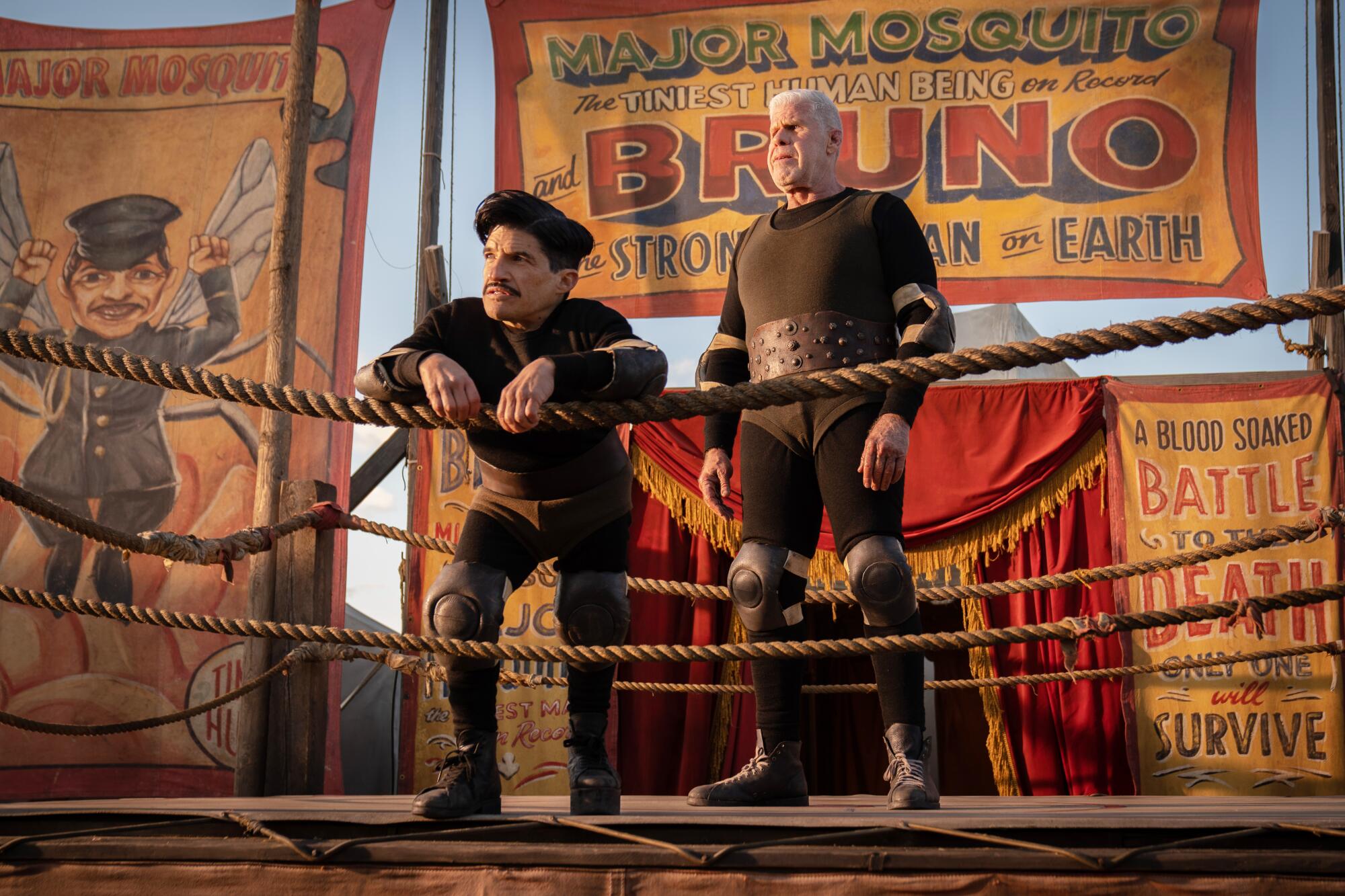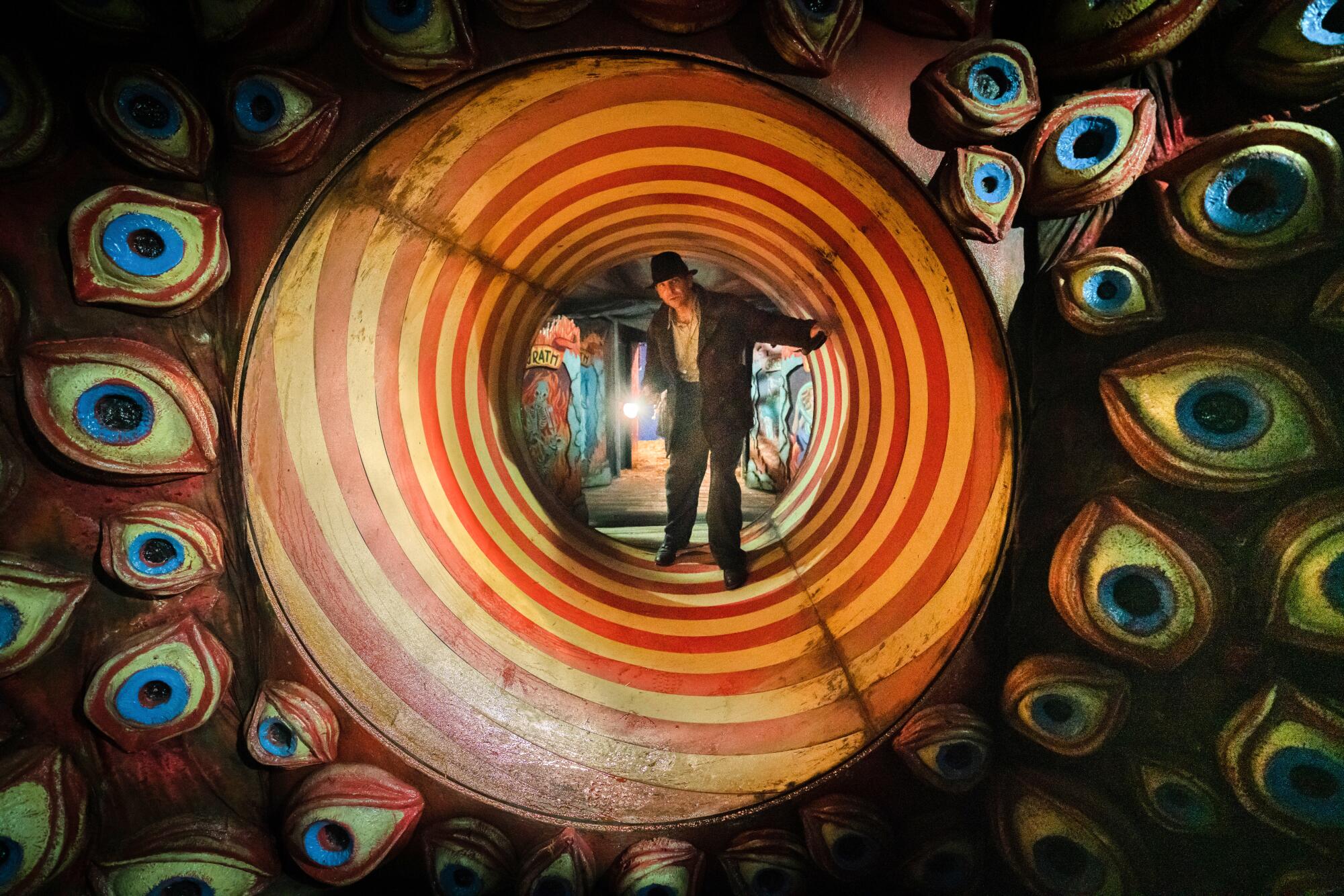
- Share via
Toronto-based production designer Tamara Deverell is fluent in the cinematic language of acclaimed director Guillermo del Toro. Well-versed in his recurrent visual motifs, thematic fascinations and detail-oriented mind-set, she knows exactly how to satisfy his vision.
Prior to their collaborative world-building on his newest release, the noir saga “Nightmare Alley,” Deverell served as art director on 1997’s “Mimic,” Del Toro’s first English-language film, and nearly two decades later crafted the sets for four seasons of “The Strain,” a horror episodic project that Del Toro created and executive produced.
“We don’t do a lot of talking,” Deverell tells The Envelope about their creative relationship. “I find that my way of working with Guillermo is to sit with him and draw.”
First, the director presents her with loose drawings of spaces created by concept designer Guy Davis. These are not drafts she can replicate, but they capture the aesthetic Del Toro is after, she says. Based on those samples, she embarks on period-specific research. After sharing key elements of her findings with him, she draws the set plans with him.
For the first segment of “Nightmare Alley,” adapted from the 1946 novel by William Lindsay Gresham, as the mysterious Stanton Carlisle (Bradley Cooper) learns the ropes of life as part of a traveling 1930s carnival, Deverell and her team built the sideshow on the grass parking lot of an agricultural fair surrounded by cornfields.
“It still amazes me that we found that,” she says. “Outside of all the big lighting cranes and rain towers around, it was really like walking into this magical, sad, Midwestern carnival.”


To assemble this crucial location, the production rented a brightly colored Ferris wheel, an original from the first half of the 20th century that remains in use today, and found a carousel from the 1920s that they embellished with calliopes. Circles, and rotation, were a prominent symbol throughout, not only via these rides, but also in the geek pit in an early sequence and the round stage were Stan performs at the Copacabana later in the film.
Deverell’s team bought, treated and dyed the fabric for the tents onscreen, before sending it along to a company in the Midwest that has specialized in making circus tents since the 1890s. Once the finished products came back, they still had to weather them to achieve an age-appropriate appearance.
While the look of most of the attractions derived from historical references, the fun house signified Del Toro’s personal addition to this parade of rarities. Deverell recalls the initial idea featured cautionary scenes depicting heaven, purgatory and eventually hell.
But given the lack of space, since the interior had to be constructed inside a sound stage, they zeroed in on the darker elements. “It was about looking at your reflection, ‘Are you a sinner?’ and the heavy Catholic themes that Guillermo likes to play with,” she notes. The design pieces included large, carved Mardi Gras-type heads of the devil and a skull.

As a tribute to their first outing together, Deverell and Del Toro adorned “Nightmare Alley” with “Mimic”-related Easter eggs. The most notable materializes during the opening act as Stan and Clem (Willem Dafoe) dispose of a man at the Salvation Army.
“In ‘Mimic,’ I designed a ‘Jesus Saves’ cross, which is actually based on a neon cross outside of a church here in Toronto,” she says. “And when we went into ‘Nightmare Alley,’ he said, ‘Let’s do that same cross.’ It was Guillermo’s idea.”
When the story later takes Stan, a charming charlatan, into the high society of the city of Buffalo, Art Deco becomes the dominant architectural style of Deverell’s sets. The office where the alluring psychologist Lilith Ritter (played by Cate Blanchett) treats Stan was the pièce de résistance.
“It was one of the more complicated sets I’ve ever built,” she noted. “You are not aware of it when you look at it, I hope, but it certainly took a long time to draft and for our excellent carpenters to put together.”
Largely inspired by the Weil-Worgelt Study at the Brooklyn Museum, Lilith’s practice exudes a powerful seductiveness. Long and narrow, so that Del Toro could choreograph the actors, the space sports Rorschach wood veneer walls and real marble floors. A skylight and a massive window provided cinematographer Dan Laustsen with light sources.
“There were plenty of difficult things to build: little secret drawers and panels, she had to pull out a recorder and there were buttons under her desk, a door was a safe that Guillermo wanted to shoot through and there was a door that went out a back hall,” Deverell says. Ultimately, she was pleased the director showed every corner and painstaking characteristic of that room throughout Cooper and Blanchett’s scenes there.
“I was complimented by Cate saying she really loved the set,” she adds. “For it to work so well for an actor of her caliber was a real thrill for me.” Deverell recently finished work on Del Toro’s upcoming genre anthology series “Cabinet of Curiosities” for Netflix.
More to Read
Sign up for The Envelope
Get exclusive awards season news, in-depth interviews and columnist Glenn Whipp’s must-read analysis straight to your inbox.
You may occasionally receive promotional content from the Los Angeles Times.








